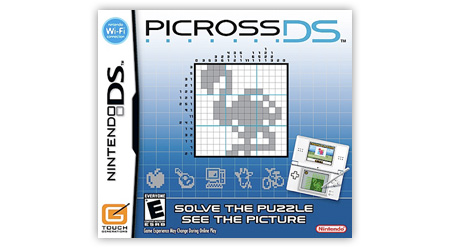
Grids, numbers, and logic. What comes to mind at mention of such things?
Countless squares filled with seemingly random numbers here and there, all working towards some final solution that one without a deep background in mathematics might never fully understand. These things should be kept under wraps in the cold, dark recesses of Excel files and databases.
But what is this? I've been having quite a good deal of fun over the last few days with all these things. No, I've not gone completely mad (yet); you won't find me poring over any massive spreadsheets or manually entering thousands of bits of data into MySQL in the late of night.
No, I've found myself yet another game to add to the collection, and a fun little one at that.
Picross DS.
As an artist who has embraced the pixel for many years, I've had my eye on games like Picross DS for quite some time, but never really had a chance to get into it fully. The previous Gameboy version was unfortunately released before I ever owned a Gameboy myself, though I do remember reading about it in Nintendo Power. If it counts for anything, I have trained for the game somewhat, with innumerable hours in Mario Paint, working with the limited collection of user-editable stamps.
So I strolled into Circuit City the other day, just to see if I could find anything cheap, and sure enough, there was a bargain bin set up with an assortment of games inside. I nabbed two games for only about $30 total: Picross DS and Lost: Via Domus (or Lost: Easy Achievement Points, as I like to call it).
My time with Picross has been thoroughly enjoyed so far. The game is addictive, contains many puzzles, and works great with the DS's touch-screen interface.
Playing the game is simple enough; each puzzle consists of a grid of empty squares, and it is up to you to use the numerical clues around the edge of the board to figure out which cells are filled and which aren't. The clues indicate how many cells in each row and column are filled, and how they are grouped (so for example, a row labeled "1 1 2" has three segments of filled cells in it, and each segment is 1, 1, and 2 fills long, in that order). You are given 60 minutes to finish each puzzle, and any mistakes made usually result in a 2-4 minute penalty. The game is over and you win when you've correctly identified and marked all the cells that are filled.
The game includes multiple modes, a tons of puzzles, and can also be played against other people online. Nintendo has also released a good number of downloadable puzzles, including many from the original game, which you can grab off the Nintendo WiFi network. I've already downloaded a bunch of these, and I've assembled Mario's head, a Goomba, and a Bullet Bill. 15x15 puzzles are pretty intense!
For some sweet icing on an already sweet cake, Picross DS also includes a built-in editor so you can craft your own puzzles and send them to friends via WiFi or local connection.
I'm actually going to stop writing this now, so I can get in a little bit more Picross DS before I hit the sack for the night. The game's been out for a while now, but I still feel it's worth mentioning here, so anyone out there in search of an oft-overlooked puzzle game might find another solid addition to their DS library.
Anyway, thanks for reading, and hope you enjoy the game if you try it!